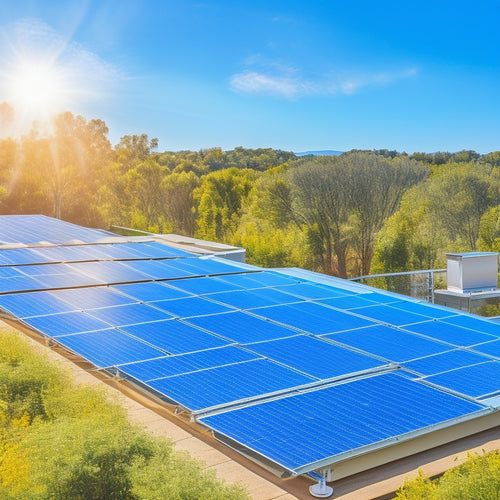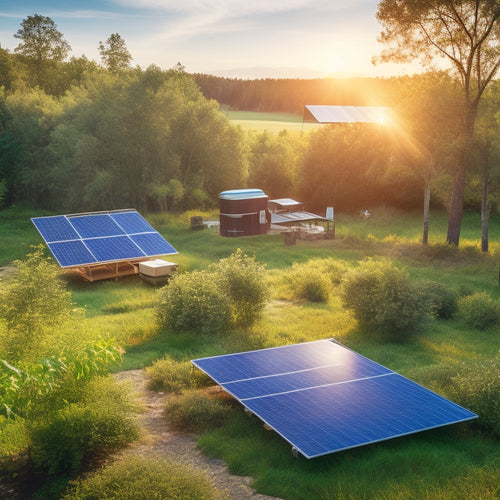
What's the Cost of Going Green at Home
Share
When you decide to go green at home, you can expect to invest between $15,000 to $30,000 in upfront costs for a typical residential solar panel system, with quality installation and high-efficiency panels playing a significant role in determining the overall cost. Factors like system size, material quality, and battery storage also impact the total expense. Additionally, you'll need to budget for energy-efficient appliances and home upgrades, which can range from $500 to $3,000. While the initial investment may seem steep, you'll start to see substantial savings on your utility bills and increased home value over time - and there's more to investigate when it comes to maximizing your eco-friendly investment.
Overview
- The upfront cost of solar panels ranges from $15,000 to $30,000, depending on system size and complexity.
- High-quality materials and proper installation are crucial for better performance, energy savings, and durability.
- Homeowners can expect a 20-30% reduction in utility bills and a 10-15% increase in home value after green upgrades.
- Federal and state incentives, such as tax deductions and rebates, can significantly reduce the overall cost of going green.
- Long-term savings from energy-efficient appliances and solar panels can lead to a 50% reduction in maintenance costs over time.
Understanding Solar Panel Costs
Pondering investing in solar panels for your home can be a challenging task, especially when it comes to understanding the costs involved. You're not alone in this pursuit, as many homeowners are looking to shift to renewable energy sources.
One of the most significant factors to reflect on is the upfront cost of purchasing and installing solar panels, which is heavily influenced by system size and complexity. Larger systems require more components and intricate system integration, raising costs exponentially.
However, there are solar financing options available that can help make this investment more accessible. Additionally, installing solar panels can lead to significant long-term savings through increased residential energy efficiency.
Average Installation Prices
Your solar panel system's installation prices vary widely, depending on several key factors, including the system's size, quality, and installation company.
On average, a typical residential solar panel system can cost anywhere from $15,000 to $30,000 or more. However, with federal and state incentives, you can greatly reduce your upfront costs.
For instance, the choice of high-efficiency panels can impact installation costs and return on investment. Additionally, accurate system sizing guarantees adequate power generation, while proper wire management minimizes energy losses.
For example, the federal solar investment tax credit (ITC) allows you to claim a tax credit of 26% of your total system cost. Additionally, many states offer rebates and incentives for energy-efficient home upgrades.
By investing in a solar panel system, you'll not only increase your energy efficiency but also enhance your home's value.
With the right installation company, you can enjoy considerable long-term savings on your energy bills.
Factors Affecting System Cost
When you're considering going green at home, you'll quickly realize that the cost of a system depends on several key factors.
You'll need to think about the size of the system you need, the quality of the materials used, and the complexity of the installation process.
The type of solar battery storage system you choose, such as lithium-ion batteries like Tesla Powerwall, will also impact the cost, with prices ranging from $400 to $900 per kWh.
These variables will greatly impact the final cost of your green home upgrade.
System Size Matters
Beyond the type of solar panels and equipment, the size of your system plays a significant role in determining the overall cost of going green at home. The larger the system, the more solar panels and equipment you'll need, which increases the cost. However, a larger system also means more energy efficiency and a greater reduction in your carbon footprint.
| System Size (kW) | Solar Capacity (panels) | Estimated Cost |
|---|---|---|
| 3-4 kW | 10-12 panels | $15,000 - $20,000 |
| 5-6 kW | 20-24 panels | $25,000 - $35,000 |
| 7-8 kW | 28-32 panels | $35,000 - $45,000 |
| 9-10 kW | 36-40 panels | $45,000 - $55,000 |
When determining the size of your system, consider your energy usage and the amount of space available for installation. A system that's too small won't meet your energy needs, while one that's too large will be a waste of money.
Material Quality Varies
As you traverse the process of going green at home, you'll uncover that material quality greatly impacts the overall cost of your solar panel system.
The type of materials used can considerably affect the system's efficiency and durability. Eco-friendly materials and sustainable alternatives can be more expensive, but they offer long-term benefits and a clear conscience.
High-quality materials, such as premium solar panels, may come with a higher upfront cost, but they can provide better performance and a longer lifespan.
On the other hand, lower-quality materials may be cheaper initially, but they may require more frequent replacements, leading to higher costs in the long run.
It's crucial to weigh the pros and cons of each material option to find the best fit for your budget and environmental goals.
Installation Complexity
The complexity of your solar panel system's installation greatly affects its overall cost. As you consider going green, you'll face installation challenges that can drive up costs.
For instance, if your roof is complex or has multiple levels, the installation process becomes more complicated, increasing labor costs. On the other hand, if you have a simple, single-level roof, installation is generally easier and less expensive.
You may also opt for DIY options, which can reduce labor costs, but require significant time and effort from you.
It's crucial to assess your roof's complexity and installation requirements to accurately estimate the total cost of your solar panel system. By understanding these factors, you can make informed decisions and enjoy the benefits of renewable energy while keeping costs in check.
Breakdown of Equipment Costs
You'll likely need to invest in various equipment to make your home more eco-friendly, and understanding the costs involved is essential for budgeting purposes. The cost of equipment can vary depending on the type and quality you choose. Here's a breakdown of some common equipment costs:
| Equipment | Average Cost |
|---|---|
| Energy Efficient Appliances | $500-$2,000 |
| Home Insulation | $1,000-$3,000 |
| Solar Panels | $15,000-$30,000 |
Keep in mind that these are rough estimates, and the actual cost may vary depending on your location, home size, and other factors. By understanding these costs, you can plan and budget accordingly to make your home more energy-efficient and eco-friendly.
Incentives and Tax Credits
You'll be happy to know that switching to eco-friendly solutions doesn't have to break the bank.
The government offers federal tax incentives to help offset the costs of going green.
Additionally, you may be eligible for state rebate programs and local government grants that can further reduce your expenses.
Federal Tax Incentives
How much can you really save by going green at home? You can greatly reduce your expenses with federal tax incentives. The government offers federal benefits to homeowners who invest in eco-friendly solutions.
For instance, you can claim tax deductions for energy-efficient upgrades like solar panels, wind turbines, and geothermal heat pumps. These energy credits can amount to thousands of dollars in savings.
Additionally, you can examine green financing options, such as energy-efficient mortgages and property-assessed clean energy (PACE) financing, which provide favorable loan terms for environmentally friendly projects.
State Rebate Programs
Beyond federal tax incentives, state rebate programs offer additional opportunities to save money on eco-friendly home upgrades. You can take advantage of these programs to reduce the cost of going green. Many states provide rebates for renewable energy systems, energy-efficient appliances, and sustainable building materials.
| State | Rebate Programs |
|---|---|
| California | California Solar Initiative (CSI) - up to $2.50 per watt for solar panels |
| New York | NY-Sun Incentive Program - up to $1.00 per watt for solar panels |
| Texas | Renewable Energy Property Tax Exemption - 100% exemption on property taxes for renewable energy systems |
| Florida | Florida Renewable Energy Technologies and Energy Efficiency Act - up to $500,000 in rebates for renewable energy systems |
Remember to research your state's specific programs and eligibility requirements to maximize your savings. By combining federal and state incentives, you can greatly reduce the cost of making your home more energy-efficient and eco-friendly.
Local Government Grants
Local governments offer additional incentives to encourage homeowners to adopt eco-friendly practices, and these grants can provide significant financial support for your green home upgrades.
You'll need to check your local government's website to determine grant eligibility and funding sources. The application process typically involves submitting a proposal outlining your sustainable project, including its environmental benefits and budget.
Some local programs offer grants for specific initiatives, such as energy-efficient windows or solar panels. Others support community initiatives, like community gardens or green roofs.
By taking advantage of these grants, you can offset the cost of going green and contribute to a more sustainable future.
Research local programs in your area to see what's available and start planning your eco-friendly project today.
Long-Term Savings Projections
Within a decade of implementing eco-friendly upgrades, homeowners can expect to reap significant long-term savings. By investing in energy-efficient solutions and sustainable materials, you'll reduce your utility bills and lower your maintenance costs. This not only benefits your wallet but also reduces your environmental impact and carbon footprint.
| Long-Term Savings | Benefits |
|---|---|
| 20-30% reduction in utility bills | Lower energy consumption |
| 10-15% increase in home value | Increased property value |
| 50% reduction in maintenance costs | Fewer repairs and replacements |
Frequently Asked Questions
Can I Install Solar Panels on My Rented Property?
You'll need your landlord's permission to install solar panels on your rented property, which can be a challenge. If they agree, you'll still face installation challenges, like ensuring the roof's structural integrity and managing local permits.
Are Energy-Efficient Appliances Worth the Extra Cost?
You're wondering if energy-efficient appliances are worth the extra cost. They typically last longer, with an average lifespan 10-15 years longer than traditional ones, and provide significant energy savings, which can offset the initial investment over time.
Will Going Green at Home Increase My Property Value?
You're wondering if going green at home will enhance your property value. The answer is yes, as green renovations using eco-friendly materials can increase your home's appeal and resale value, making it more attractive to potential buyers.
How Long Does It Take to See a Return on Investment?
You'll see a return on investment in eco-friendly home upgrades when energy savings cover the initial cost, typically within 5-10 years, depending on the upgrade, with a shorter payback period for more efficient solutions.
Can I Go Off-Grid With My Renewable Energy System?
You can achieve energy independence with a well-designed renewable energy system, but going completely off-grid requires careful planning, significant investment, and a commitment to sustainable living, allowing you to break free from reliance on public utilities.
Ready to Buy
Now that you've seen the numbers, you're probably wondering: is going green at home worth the cost? The answer is, it depends on your priorities. If saving the planet is your top concern, the cost might be a small price to pay. But if you're looking for a quick return on investment, you might want to wait until prices drop. One thing's for sure, though - with incentives and tax credits, the cost of going green is more within reach than you think. Will you take the leap?
Related Posts
-

What Types of Solar Energy Devices Are Available
You'll find several types of solar energy devices available today, each customized to different energy needs. Photovo...
-

Top Portable Refrigerators for Camping Adventures
When you're camping, having a reliable portable refrigerator can make all the difference for keeping your food fresh ...
-

Top Off Grid Solar Batteries for Renewable Energy
When seeking top off-grid solar batteries for renewable energy, consider options with advanced battery chemistry, suc...


